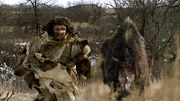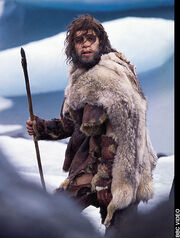
A male Neanderthal being chased by a Woolly rhinoceros (Mammoth Journey)
The Neanderthal was a prehistoric human featured in Walking with Beasts and Walking with Cavemen. They were one of the first humans to bury the dead and are also rumored to have had a proportionally larger brain than even modern humans. We know much more about them then many other prehistoric animals, mostly because they lived relatively recently and are closely related to us.

Facts[]
The Neanderthals or Neandertals (/niˈændərˌθɔːlz/, /niˈændərˌtɔːlz/, /niˈændərˌtɑːlz/, /neɪˈɑːndərˌtɑːlz/ or /niˈændərθəlz/) are an extinct species of human in the genus Homo, possibly a subspecies of Homo sapiens.
They are closely related to modern humans, differing in DNA by only 0.3%, just twice the variability across contemporary humans.
Remains left by Neanderthals include bones and stone tools, which are found from western Europe to central Asia. The species is named after Neandertal ("Neander Valley"), the location in Germany where it was first discovered.
Neanderthals are generally classified by palaeontologists as the species Homo neanderthalensis, but a minority consider them to be a subspecies of Homo sapiens, (Homo sapiens neanderthalensis).
The first humans with proto-Neanderthal traits are believed to have existed in Europe as early as 600,000–350,000 years ago.
The exact date of their extinction is disputed. Fossils found in the Vindija Cave in Croatia have been dated to between 33,000 and 32,000 years old, and Neanderthal artifacts from Gorham's Cave in Gibraltar are believed to be less than 30,000 years old, but a recent study has redated fossils at two Spanish sites as 45,000 years old, 10,000 years older than previously thought, and may cast doubt on recent datings of other sites. Cro-Magnon (early-modern-human) skeletal remains showing some "Neanderthal traits" have been found in Lagar Velho (Portugal) and dated to 24,500 years ago, suggesting that there may have been an extensive admixture of the Cro-Magnon and Neanderthal populations in that region.
Several cultural assemblages have been linked to the Neanderthals in Europe. The earliest, the Mousterian stone tool culture, dates to about 300,000 years ago.
Late Mousterian artifacts were found in Gorham's Cave on the south-facing coast of Gibraltar.
Other tool cultures associated with the Neanderthals include the Châtelperronian, the Aurignacian, and the Gravettian; their tool assemblages appear to have developed gradually within their populations, rather than being introduced by new population groups arriving in the region.
With an average cranial capacity of 1600cc, Neanderthal's cranial capacity is known to be notably larger than the 1400cc average for all races of modern humans, indicating that their brain size was at least as large, if not larger. In 2008, a group of scientists produced a study using three-dimensional computer-assisted reconstructions of Neanderthal infants based on fossils found in Russia and Syria. The study indicated that Neanderthal and modern human brains were the same size at birth, but by adulthood, the Neanderthal brain was larger than the modern human brain.
At least one experiment indicates they had high, loud, squeaky and somewhat "creepy" voices.
They were much stronger than modern humans, having particularly strong arms and hands.
Males stood 164–168 cm (65–66 in) and females about 152–156 cm (60–61 in) tall.
Genetic evidence published in 2010 suggests that Neanderthals contributed to the DNA of anatomically modern humans, probably through interbreeding between 80,000 and 50,000 years ago with the population of anatomically modern humans who had recently migrated from Africa. According to the study, by the time that population began dispersing across Eurasia, Neanderthals genes constituted as much as 1–4% of its genome (roughly equivalent to having one Neanderthal great-great-great-grandparent).
Ötzi the iceman, Europe's oldest preserved mummy, was found to possess an even higher percentage of Neanderthal ancestry.
In December 2013, researchers reported evidence that Neanderthals practiced burial behavior and intentionally buried their dead.
In addition, scientists reported, for the first time, the entire genome of a Neanderthal. The genome was extracted from the toe bone of a 130,000-year-old Neanderthal found in a Siberian cave.
The neaderthal genome reveals that at least some individuals had white to white-ish skin, and brown to red hair. This may even be a genuine diagnostic.
Portrayal in the series[]
The Neanderthal is portrayed in Walking with Beasts as creatures that are a dead end in the human story. They are portrayed as mostly carnivores that drive mammoths off cliffs. At the time, it was thought they died out 30,000 years ago.
In Walking with Cavemen, they are very similar to modern humans that have big noses to cool themselves rather than warm them, because they would not want to sweat and have it freeze, while in Walking with Beasts, they have big noses for the same reason the Saiga antelope have big noses, which is warm them up.
In The Walking with... Series[]
Walking with Beasts[]
Mammoth Journey[]
One of the Neanderthals was attacked by a woolly rhinoceros and heavily gored (his tough body build enabled him, presumably, to survive that attack). Later, other Neanderthals have successfully ambushed and killed a pair of woolly mammoths as the latter were migrating back to the northern tundra. The Neanderthals are then revealed, despite lasting over 260,000 years, to have a chink in their armor: they don't cope well with change. In 2,000 years, they will become extinct altogether partly down to the change in climate, but mostly being out competed by modern humans.
Walking with Cavemen[]
The Survivors[]
A Neanderthal tribe also hunted mammoths, as well as smaller animals, such as snowshoe hares. They were very similar to the ancestors of modern humans (and their close evolutionary cousins) and may have interbred with them to some extent (though the extent to which they did this is highly debatable), but they lacked the modern humans' imaginations, and were out competed by them, when they came to Europe at the end of the Ice Age. (According to other data, the Neanderthals actually died out 10,000 years before that, save for a few possible pockets in northern and western Eurasia, due to a change of climate).
|
